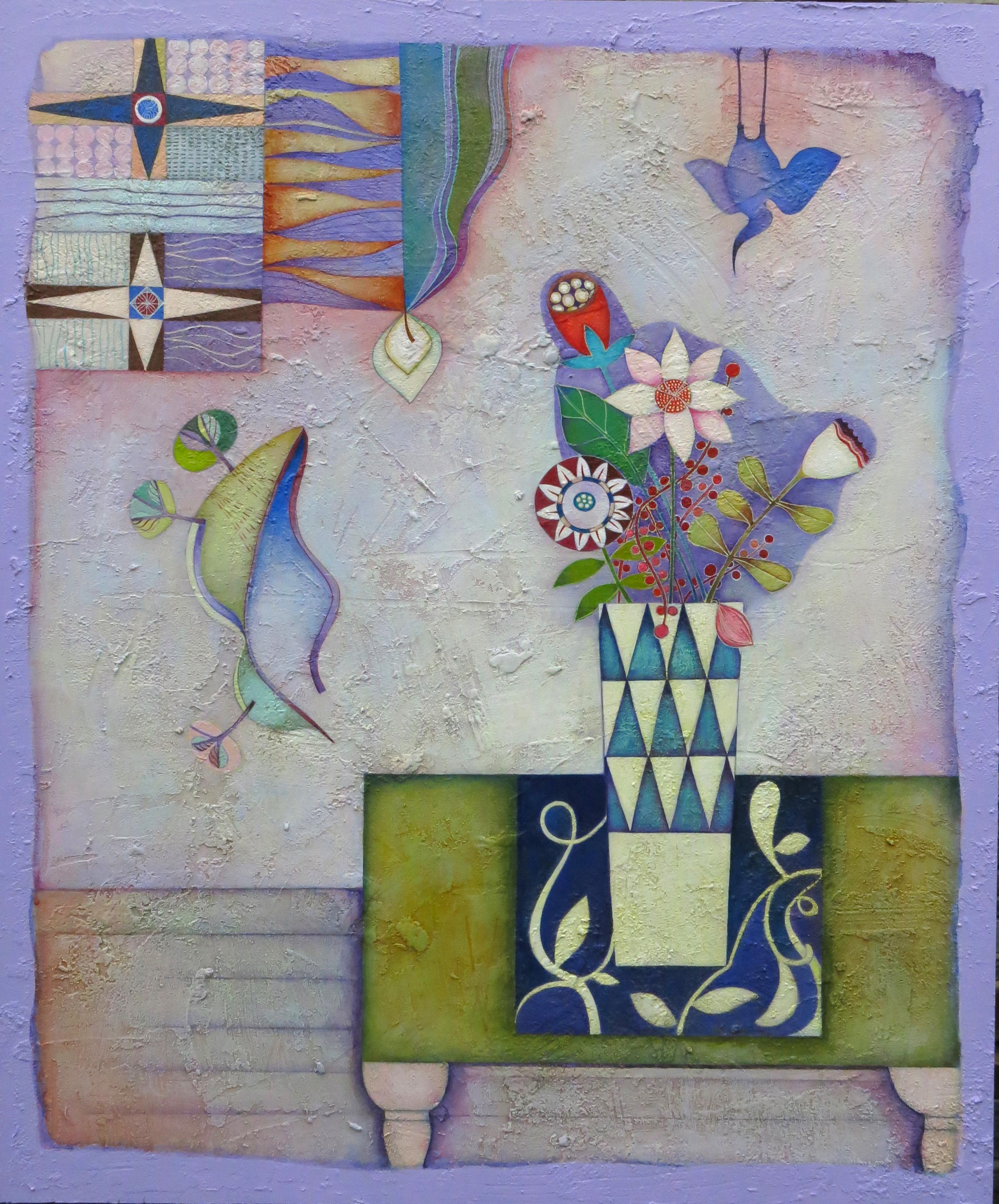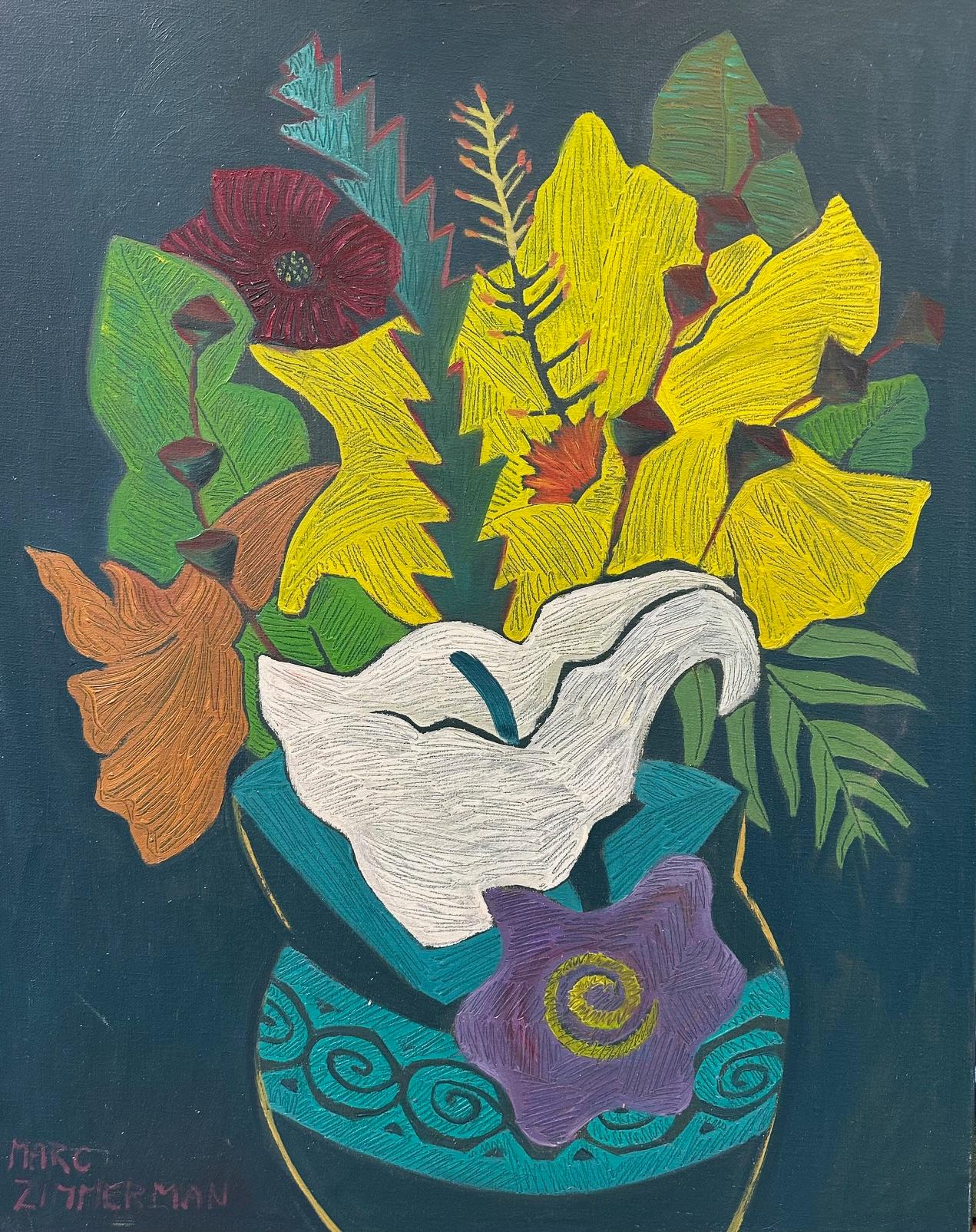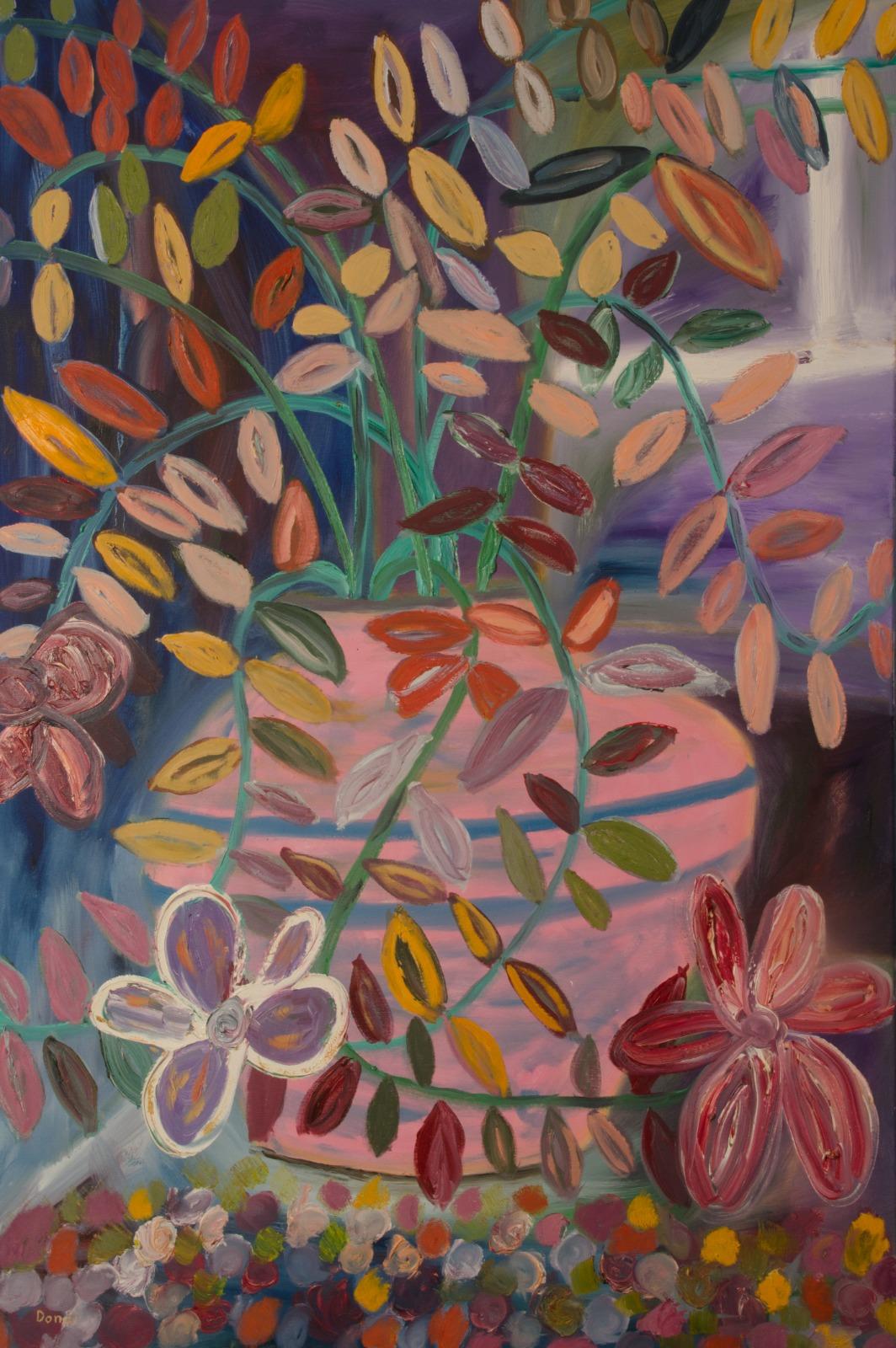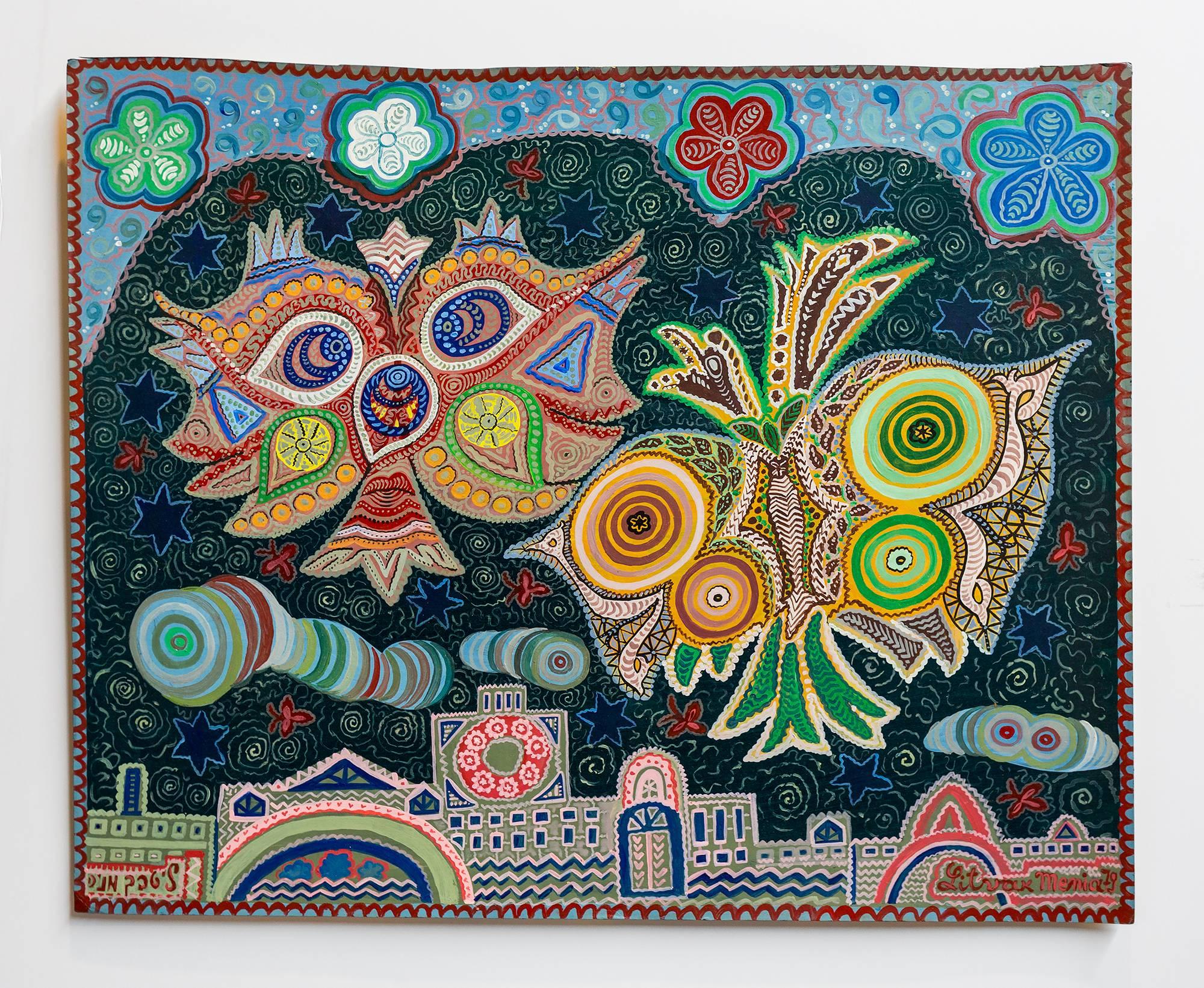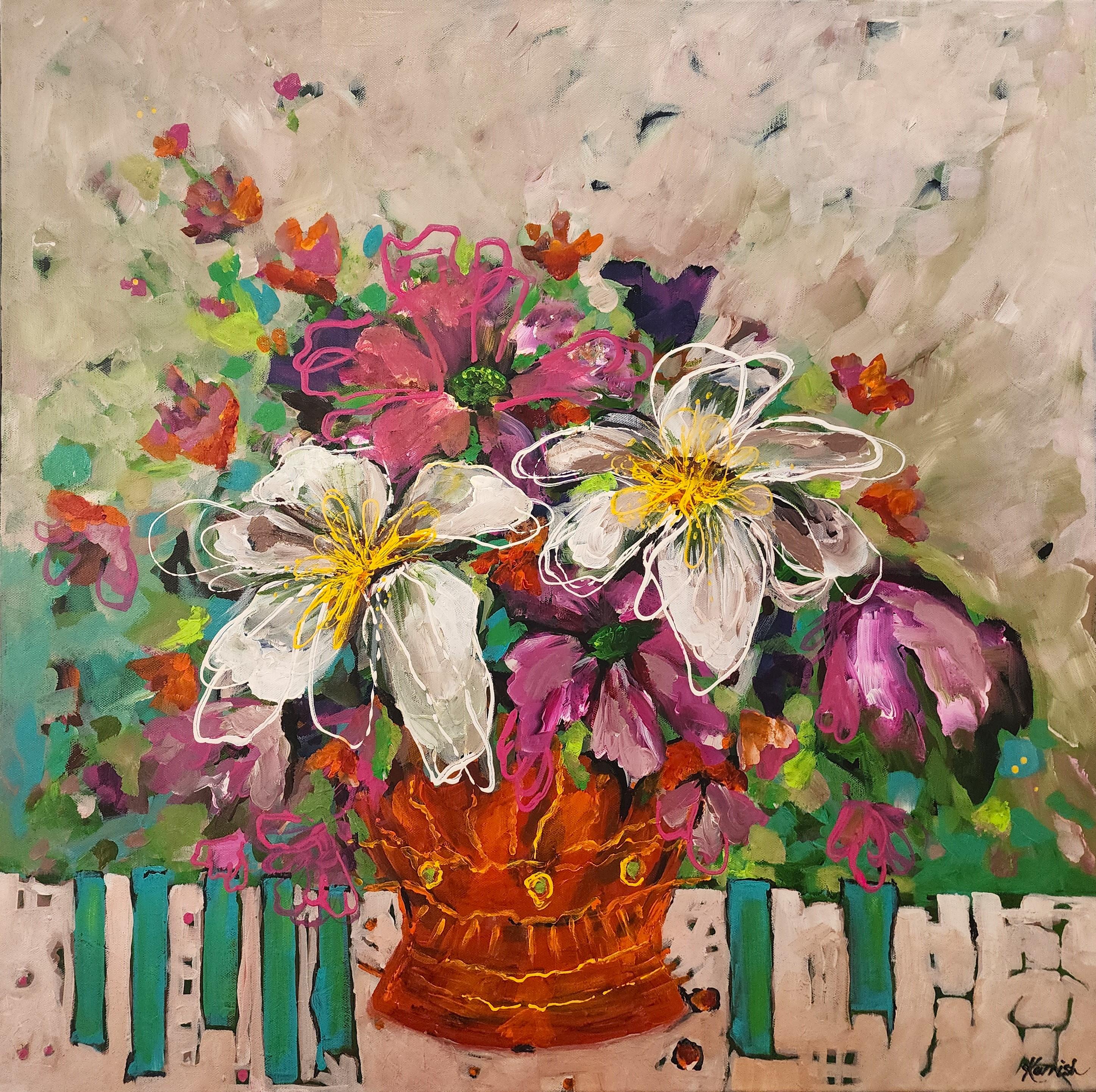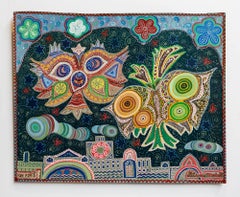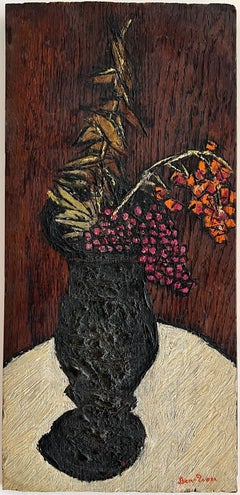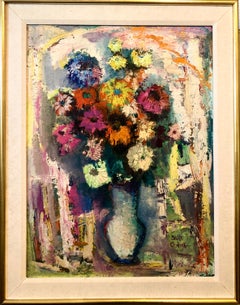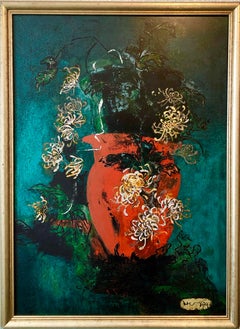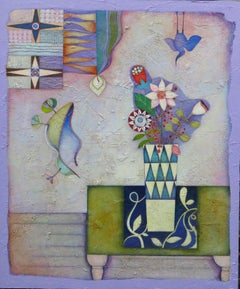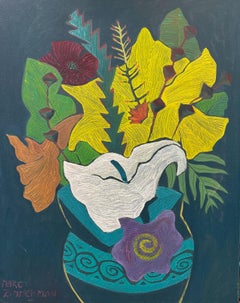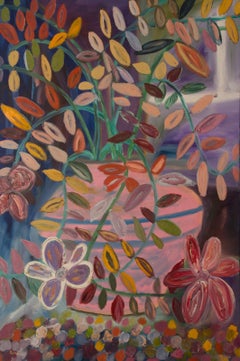Items Similar to Israeli Folk Art Bright Colorful Naive Floral Painting, Mod Flowers in Vase
Want more images or videos?
Request additional images or videos from the seller
1 of 11
Menia LitvakIsraeli Folk Art Bright Colorful Naive Floral Painting, Mod Flowers in Vase1989
1989
$1,800
£1,357.67
€1,568.12
CA$2,521.92
A$2,804.23
CHF 1,468.07
MX$34,254.25
NOK 18,447.71
SEK 17,353.77
DKK 11,705.88
About the Item
A fantastic vase of bold colorful flowers. signed and dated in Hebrew and English, Jerusalem 1989.
Litvak's life as an artist started in 1976 when he left Kishinev (Bessarabia) for Israel. In his youth he did not have the opportunity to study an regularly, although he learned painting during some two years at the Belle-Arts Academy in Kishinev and one year in Bucharest. His youth was spent during world war 2 when Bessarabia was annexed by the Soviet Union, years of hunger and the need to work very hard to be able to survive. He worked as a retoucher of photographs in a studio. When he arrived in Israel went to live in Jerusalem and took up painting as his sole occupation, not as in Russia where it was one of his occupations which he had to do sometimes in hiding, stealing time from his everyday jobs. Israel, its colourings, impressed him much: the blue of the sky, the turquoise of the sea, the palette of desert colours. The stones of Israel looked alive, he wished he
could paint them all. In 1976 he started to exhibit his work. Since then he has participated in a number of exhibitions in groups and alone. Since 1984 a member of the Israeli Union of Painters and Sculptors. The last exhibition where he took part was at the Salon des Beaux-Arts in Paris together in a group of Jerusalem artists. Israel has had a Vibrant Folk Art, Naive art scene for a long time now artists like Yisrael Paldi, Nahum Guttman, Reuven Rubin and even Yefim Ladyzhensky had naive periods. The most well know if the strict naive artists are Shalom of Safed, Irene Awret Gabriel Cohen, Natan Heber, Michael Falk and Kopel Gurwin. This is done in a style reminiscent Austrian fantastic or magic realism and bears the influence of Friedensreich Hundertwasser and Arik Brauer.
Mania Litvak - From Paris to Jerusalem
Jerusalem Artists' House, Jerusalem
24 February, 1996 - 19 March, 1996
Group Exhibitions
Exposition des Artistes de Jérusalem
Grand Palais, Paris, France 4 April, 1985 - 1 May, 1985
Artists: Ackerman, Shmuel Zohar, Israel Zavadsky, Lidia Yanai, Marek Yannay, Beba Tolkovsky, Zvi Sima, Miron Shvily, Hanna Shvadron, Eli Shenhav, Dodo Shemesh, Hedvah Shahar, Reut Schatz, Zahara Schatz, Louise Rothenberg, Sidon Remez, Varda Rakia, David Okun, Sasha (Alexander) Neustein, Joshua Litvinovsky, Pinchas Litvak, Mania Levin, Ruth Kopelovich, Alexander Heller, Rachel Harekavi, Hedva Hadany, Israel Gutkina, Vera Goldstein, George Gerstein, David (Dudu) Gavish, Galia Gafni Harnik, Nahada Fima (Roytenberg, Ephraim) Cohen, Gabriel Katz, Tuvia Brosh, Shlomi Blum, Motke (Mordechai) Bezalel, Aharon Asaph Basin, Anatoli Ardon, Mordecai
Painting on Aluminum Painting on Aluminum
Debel Gallery, Ein Kerem, Jerusalem
''Together'' - Veteran and Olim Artists ''Together'' - Veteran and Olim Artists
Holiday Inn, Jerusalem
2 October, 1993 - 12 October, 1993
Artists: Litvak, Mania Ben Shalom, Jacob Lekar (Lecar), Boris Tarkay, Yitzchak Schatz, Shaul Avnieli, Mordechai Yehudayan, Shlomo
Jerusalem Artists' House, Jerusalem
3 July, 1994 - 19 July, 1994
Artists:
Ben Moshe, Yona Blum, Motke (Mordechai) Gilhar, Dalia Weiss, Yoav Reiner, Arona Schenkelbach, Erwin Brosh, Shlomi Remez, Varda Rakia, David Jano, Jacques Shahar, Reut Oppenheimer, Giora Eyal, Malka Gavish, Galia Shemesh, Hedvah Epstein, Chava Ergas, Yemima Peiser, Hanna Kalai, Carmela Schreckinger, Jacob Caspi, Aliza Litvak, Mania
Jerusalem Artists Creat in the Refinery in Ashdod Jerusalem Artists Create in the Refinery in Ashdod.
GROUP EXHIBITIONS
1979 - Immigrant artists from USSR - Jerusalem Theatre
1981 - Painters sitting in Gilo-Jerusalem
1982 - Ludmilla Gallery, Tel-Aviv
1988 - Knesset Israel - Jerusalem
1990 - Artexpo. New York, Japan
1995 - Ashdod-Museum
ONE PERSON SHOWS
1980 - Beit Haomanim, Jerusalem
1981 - Sokolov House, Tel-Aviv
1982 - Miniatures, Municipal Gallry, Jerusalem
1983 - Debel Gallery, Jerusalem
1984 - The Artists House, Jerusalem
1985 - Jerusalem Artists in Salon de Beaux Arts, Grand Palais, Paris
1996 - The Artists House, Jerusalem
1989 - Debel Gallery, Jerusalem
1990 - Beit Haomanim, Jerusalem
1993 - Cite internationale des Art-Paris
1999 - Galleria Nora - Jerusalem
2000 - Galleria Gvanim
- Creator:Menia Litvak (Israeli, Romanian)
- Creation Year:1989
- Dimensions:Height: 27 in (68.58 cm)Width: 20 in (50.8 cm)
- Medium:
- Movement & Style:
- Period:
- Condition:
- Gallery Location:Surfside, FL
- Reference Number:1stDibs: LU38214773012
About the Seller
4.9
Platinum Seller
Premium sellers with a 4.7+ rating and 24-hour response times
Established in 1995
1stDibs seller since 2014
1,799 sales on 1stDibs
Typical response time: <1 hour
- ShippingRetrieving quote...Shipping from: Surfside, FL
- Return Policy
Authenticity Guarantee
In the unlikely event there’s an issue with an item’s authenticity, contact us within 1 year for a full refund. DetailsMoney-Back Guarantee
If your item is not as described, is damaged in transit, or does not arrive, contact us within 7 days for a full refund. Details24-Hour Cancellation
You have a 24-hour grace period in which to reconsider your purchase, with no questions asked.Vetted Professional Sellers
Our world-class sellers must adhere to strict standards for service and quality, maintaining the integrity of our listings.Price-Match Guarantee
If you find that a seller listed the same item for a lower price elsewhere, we’ll match it.Trusted Global Delivery
Our best-in-class carrier network provides specialized shipping options worldwide, including custom delivery.More From This Seller
View AllIsraeli Folk Art Bright Colorful Naive Jerusalem Vibrant Landscape Painting
By Menia Litvak
Located in Surfside, FL
My life as an artist started in 1976 when I left Kishinev (Bessarabia) for Israel. In my youth I did not have the opportunity to study an regularly, although I learned painting during some two years at the Belle-Arts Academy in Kishinev and one year in Bucarest. My youth was spent during world war 2 when Bessarabia was annexed by the Soviet Union, years of hunger and the need to work very hard to be able to survive. I worked as a retoucher of photographs in a studio. When I arrived in Israeli went to live in Jerusalem and took up painting as my only ocupation, not as in Russia where it was one of my occupations which I had to do sometimes in hiding, stealong time from my everyday jobs. Israel, its colourings, impressed me much: the blue of the sky, the turquoise of the sea, the palette of desert colours. The stones of Israel looked alive and I wished I could paint them all. In 19761 started to expose my work. Since then I participated in a number of exhibitions in groups and alone. Since 1984 I am a member of the Israeli Union of Painters and Sculptors. The last exhibition where I took part was at the Salon des Beaux-Arts in Paris together in a group of Jerusalem artists. Israel has had a Vibrant Folk Art, Naive art scene for a long time now artists like Yisrael Paldi, Nahum Guttman...
Category
20th Century Folk Art Figurative Paintings
Materials
Gouache
American Modernist Oil Painting Expressionist Vase, Flowers WPA Artist Ben ZIon
By Ben-Zion Weinman
Located in Surfside, FL
Ben-Zion (1897-1987)
Flower Piece with Black Vase
Oil on board, Hand signed 'Ben-Zion ' lower right, with the artist 's label and label from Duveen-Graham gallery, NY.
16 x 7 3/4 in., unframed as intended,
Born in 1897, Ben-Zion Weinman celebrated his European Jewish heritage in his visual works as a sculptor, painter, and printmaker. Influenced by Spinoza, Knut Hamsun, and Wladyslaw Reymont, as well as Hebrew literature, Ben-Zion wrote poetry and essays that, like his visual work, attempt to reveal the deep “connection between man and the divine, and between man and earth.”
An emigrant from the Ukraine, he came to the US in 1920. He wrote fairy tales and poems in Hebrew under the name Benzion Weinman, but when he began painting he dropped his last name and hyphenated his first, saying an artist needed only one name.
Ben-Zion was a founding member of “The Ten: An Independent Group” The Ten” a 1930’s avant-garde group, Painted on anything handy. Ben-Zion often used cabinet doors (panels) in his work. Other members of group included Ilya Bolotowsky, Lee Gatch, Adolf Gottlieb, Louis Harris, Yankel Kufeld, Marcus Rothkowitz (later known as Mark Rothko), Louis Schanker, and Joseph Solman. Over the course of the group's existence, seventeen artists exhibited as members of The Ten at nine different shows. The group's nine shows were held at galleries and locations around New York City, including one international exhibition in Paris. David Burliuk, Lee Gatch, John Graham, Earl Kerkam, Karl Knaths, Edgar Levy, Jean Liberté...
Category
Mid-20th Century Expressionist Figurative Paintings
Materials
Oil, Wood Panel
Mid Century Jewish Expressionist Oil Painting Floral Vibrant Colorful Flowers
By Belle Golinko
Located in Surfside, FL
Gestural impasto painting of flowers in a vase.
23.5" x 17.5" sight size , 22" x 28" framed
hand signed lower right.
Born in 1899, Belle Golinko is a listed Jewish mid-century New ...
Category
1950s Expressionist Still-life Paintings
Materials
Oil, Board
Bright Vibrant Pop Art Enamel Oil Painting Flowers NYC Abstract Expressionist
Located in Surfside, FL
Flowers in a Vase, intensely and seductively colored: almost in a Japonaise style. Swooning purples and reds, ecstatic lemon yellows, Jostling shapes, lyrical and soft-edged, refuse ...
Category
1990s Abstract Expressionist Figurative Paintings
Materials
Enamel
Israeli Folk Art Bright Colorful Naive Dragon Painting
By Menia Litvak
Located in Surfside, FL
My life as an artist started in 1976 when I left Kishinev (Bessarabia) for Israel. In my youth I did not have the opportunity to study an regularly, although I learned painting during some two years at the Belle-Arts Academy in Kishinev and one year in Bucarest. My youth was spent during world war 2 when Bessarabia was annexed by the Soviet Union, years of hunger and the need to work very hard to be able to survive. I worked as a retoucher of photographs in a studio. When I arrived in Israeli went to live in Jerusalem and took up painting as my only ocupation, not as in Russia where it was one of my occupations which I had to do sometimes in hiding, stealong time from my everyday jobs. Israel, its colourings, impressed me much: the blue of the sky, the turquoise of the sea, the palette of desert colours. The stones of Israel looked alive and I wished I could paint them all. In 19761 started to expose my work. Since then I participated in a number of exhibitions in groups and alone. Since 1984 I am a member of the Israeli Union of Painters and Sculptors. The last exhibition where I took part was at the Salon des Beaux-Arts in Paris together in a group of Jerusalem artists. Israel has had a Vibrant Folk Art, Naive art scene for a long time now artists like Yisrael Paldi, Nahum Guttman...
Category
20th Century Folk Art Figurative Paintings
Materials
Gouache
Bold Flowers in a Vase
By Katherine Librowicz
Located in Surfside, FL
Katarzyna LIBROWICZ
Polish French painter studied at the Academy of Fine Arts in Warsaw and arrived in France in 1937 .
She studied with André Lhote in Montparnasse Paris and exhibited at the Salon d'Automne and the Salon des Independants .
She is one of the painters of the School of Paris .
Peintre polonaise.Elle étudia à l'Académie des Beaux-Arts de Varsovie, puis arriva en France en 1937.
Elle suivit les...
Category
20th Century Figurative Drawings and Watercolors
Materials
Watercolor
You May Also Like
This time I put flowers. Raquel Fariñas Symbolic Colorful Folk Art Still-life
By Raquel Fariñas
Located in Segovia, ES
"This time I put flowers" (Esta vez puse flores), Acrylic and mixed media on wood panel, 75x60 cm.
The pictures of Raquel Fariñas are presented before our eyes with an almost naive ...
Category
2010s Folk Art Figurative Paintings
Materials
Mixed Media, Acrylic, Wood Panel
Vase With Flowers - Floral Painting By Marc Zimmerman
By Marc Zimmerman
Located in Carmel, CA
Floral - Abstract Painting - Oil On Canvas By Marc Zimmerman
Marc Zimmerman creates playful paintings, whether deep mysterious jungle or delightfully whimsical florals. His color ...
Category
2010s Contemporary Abstract Paintings
Materials
Canvas, Oil
Israeli Contemporary Art by Dondi Schwartz - Vase with Flowers
Located in Paris, IDF
Oil on canvas
Category
2010s Contemporary Figurative Paintings
Materials
Oil, Canvas
Women with Flowers, Folk Art Acrylic Painting by Ernani Silva
Located in Long Island City, NY
Ernani Silva, Brazilian - Women with Flowers, Medium: Acrylic, Collage and Enamel on board, signed in marker, Size: 9.25 x 27.5 in. (23.5 x 69.85 cm)
Category
1990s Folk Art Figurative Paintings
Materials
Enamel
Still-life Painting Floral Vase Colorful Flower Original Contemporary Investment
By Karnish Art
Located in Cullinan, ZA
Title: Treasure Trove in Bloom
Still-life Painting Floral Vase Colorful Flower Original Contemporary Investment One-of-a-kind Original Artwork
You can buy yourself flowers!
This ...
Category
2010s Abstract Expressionist Still-life Paintings
Materials
Acrylic, Canvas, Wood, Stretcher Bars
Colourful floral painting print on canvas, Michael Flowers
Located in New York, NY
Medium and Large Size print edition on canvas. Framing options included in Black, White and Natural wood framing. Please contact seller for the same.
Print Edition on Canvas
Available Sizes:
24" x 20" - $835
48" x 40" - $1600
BIO
Basmat Levin is an Israeli artist works between her studios in Shanghai M-50 and NYC. Her works were exhibited at ArtCN Gallery, Leo Gallery, I-Green Shanghai Pujiang Park.,Zhoupu Art Museum Why Why Art, Tangram Gallery , Dunhill Twin Villa, Shanghai . Ischam Gallery, 798, Beijing. Leo Gallery, the Baptist University Hong Kong. Art stage
Singapore. ML Gallery, Antwerp, Belgium. Israel Opera House and Frishman 46 Art Space Tel Aviv to name a few.
Her latest Installations include, ‘Message in a bottle’. A sustainable art installation, printed on recycled ocean plastic bottles fabrics, at Glam, Shanghai. 1410 Broadway, (ZAZ10TS), a building installation Times Square NYC., the MOCA Museum Pavilion, Shanghai, I-Green Pujiang Park, Souzho Village, a 23 x 8 meter “ Magic Wall “ of 60 of her painting. An outdoor building...
Category
21st Century and Contemporary Abstract Abstract Prints
Materials
Canvas
More Ways To Browse
Israel Jerusalem
Hebrew Art
Vintage Japanese Flower Art
Israel Photographs
Russian Flower Painting
Flowers Blue Vase Painting
Michael Israel
Colorful Folk Art Painting
Georges Israel
Ben Long
House Alive Vintage
Ruth Mayer
Israel Vase
Shalom Vintage
Jerusalem Stone
Soviet Realism Painting
Turquoise Japanese Vase
Naive French Folk Art Painting
